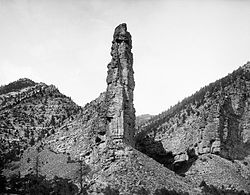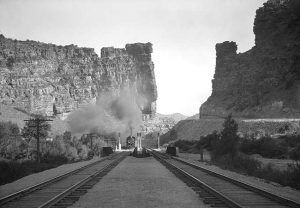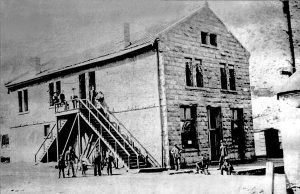
They made of with an estimated at $8,800

Men earned 60 cents for every ton of coal removed from the mine. Working alongside their fathers, boys as young as six-years-old loaded the ore into coal cars, carefully removing any rocks.

Castle Gate Mine #1, opened around 1886, after the Denver and Rio Grande Western Railroad constructed its Utah Division over the Wasatch Plateau, from the town of Springville. The mine produced high-quality coal for the steam trains.
In November 1903 miners in Carbon County went on strike, protesting the dangerous working conditions of the Utah coal mines and sought better wages and hours.
 March 8, 1924, was a cold Saturday morning. Sometime before 7:00 a.m., 171 miners entered Castle Gate Mine #2. At 7:30 a.m., less than an hour later, a fire boss had discovered some gas near the roof of the mine tunnel. When he climbed up to investigate, his carbide light went out. When he attempted to relight his lamp, the flame from his match ignited the gas.
March 8, 1924, was a cold Saturday morning. Sometime before 7:00 a.m., 171 miners entered Castle Gate Mine #2. At 7:30 a.m., less than an hour later, a fire boss had discovered some gas near the roof of the mine tunnel. When he climbed up to investigate, his carbide light went out. When he attempted to relight his lamp, the flame from his match ignited the gas.
 The gas and the coal dust set off a gigantic explosion that ripped through the mine with such force that wreckage was spewed nearly half a mile across the canyon.The explosion blew out the carbide lamps of all the men in the mine. When the men tried to light their lamps, they set off another explosion that took out the wall of the mine's fan house. Twenty minutes later, a third explosion sliced the mine's steel doors from its concrete frame.
The gas and the coal dust set off a gigantic explosion that ripped through the mine with such force that wreckage was spewed nearly half a mile across the canyon.The explosion blew out the carbide lamps of all the men in the mine. When the men tried to light their lamps, they set off another explosion that took out the wall of the mine's fan house. Twenty minutes later, a third explosion sliced the mine's steel doors from its concrete frame.
The mine entrance and main tunnel caved in. Rail lines twisted. Roof supports snapped. Ventilation controls were destroyed, and the air and escape shafts filled with gas.
Rescue workers came from all the surrounding areas to help. The leader of the rescue crew, died from carbon monoxide inhalation while attempting to reach the victims shortly after the explosion. Women cooked for bereaved families, tended children, and sew mourning clothing.

In November 1903 miners in Carbon County went on strike, protesting the dangerous working conditions of the Utah coal mines and sought better wages and hours.
The Utah Fuel Company didn't like this and restricted credit payments to the strikers and evicted them from their homes. The company then recruited local farmers to work in the mines. The Utah government also sent in the Utah National Guard.
A tent colony for the striking miners had been established between Helper and Castle Gate. In April 1904 labor organizer Mother Jones arrived in Utah which led to a confrontation between local law-enforcement officers and the strikers. On April 25, the sheriff and a 45-man posse entered the camp and arrested 120 Italians who were herded into boxcars and sent to a makeshift jail in Price to await trial. Eleven were found guilty of various offenses and the rest were set free.
Castle Gate Mine #2 opened in 1912, and was found to have the finest coal in the region. In 1914, Castle Gate was incorporated as a town, which was owned and tightly controlled by the Utah Fuel Company and the D&RGW. A third mine opened in 1922.

Castle Gate Mine #2 opened in 1912, and was found to have the finest coal in the region. In 1914, Castle Gate was incorporated as a town, which was owned and tightly controlled by the Utah Fuel Company and the D&RGW. A third mine opened in 1922.

Rescue workers came from all the surrounding areas to help. The leader of the rescue crew, died from carbon monoxide inhalation while attempting to reach the victims shortly after the explosion. Women cooked for bereaved families, tended children, and sew mourning clothing.


It took nine days to recover all of the bodies, not one soul survived.


No comments:
Post a Comment